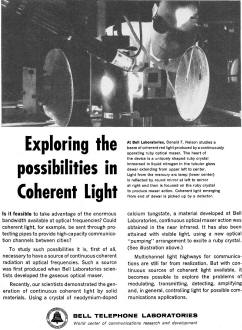Bell Telephone Laboratories - Coherent Light
|
|
In 1962 when this Bell Telephone Laboratories infomercial appeared in Electronics World magazine, scientists were in the early stages of developing communications via light signals. Most lasers (light amplification by stimulated emission of radiation) were still of the ruby type mentioned here. In fact, it was only two years previous in 1960 that Theodore Maiman created the world's first "optical maser" using a ruby. The term "maser" ("microwave amplification by stimulated emission of radiation") seems to be a bit of a misnomer, but under the proper conditions it could operate in the visual or infrared regions of the electromagnetic spectrum. "Could coherent light, for example, be sent through protecting pipes to provide high-capacity communication channels between cities?," the copy asks. We now know the answer to that question as optic fiber now spans the globe, literally. This is one of the main reasons I like to post these items from vintage magazines: to remind - or maybe to inform for the first time - people of who it was that developed all the knowledge taken for granted by such a large fraction of the population. Of course many of the "cancel culture" Bozos who want to punish companies and individuals for having existed at a time when cultural and societal standards were different have no interest in according due credit to those who came before them regardless of their accomplishments. Bell Telephone Laboratories Ad
At Bell Laboratories, Donald F. Nelson studies a beam of coherent red light produced by a continuously operating ruby optical maser. The heart of the device is a uniquely shaped ruby crystal immersed in liquid nitrogen in the tubular glass Dewar extending from upper left to center. Light from the mercury arc lamp (lower center) is reflected by round mirror at left to mirror at right and then is focused on the ruby crystal to produce maser action. Coherent light emerging from end of Dewar is picked up by a detector. Is it feasible to take advantage of the enormous bandwidth available at optical frequencies? Could coherent light, for example, be sent through protecting pipes to provide high-capacity communication channels between cities? To study such possibilities it is, first of all, necessary to have a source of continuous coherent radiation at optical frequencies. Such a source was first produced when Bell Laboratories scientists developed the gaseous optical maser. Recently, our scientists demonstrated the generation of continuous coherent light by solid materials. Using a crystal of neodymium-doped calcium tungstate, a material developed at Bell Laboratories, continuous optical maser action was obtained in the near infrared. It has also been attained with visible light, using a new optical "pumping" arrangement to excite a ruby crystal. (See illustration above.) Multichannel light highways for communications are still far from realization. But with continuous sources of coherent light available, it becomes possible to explore the problems of modulating, transmitting, detecting, amplifying and, in general, controlling light for possible communications applications. Bell Telephone Laboratories World center of communications research and development
Posted June 14, 2021 |
|

